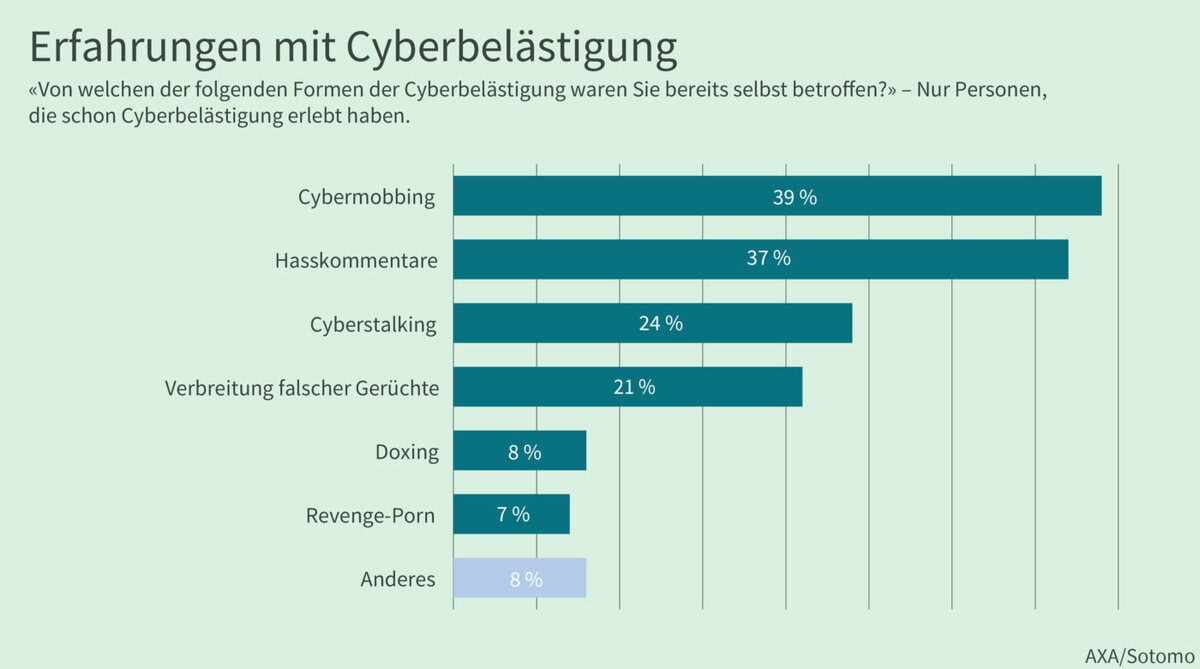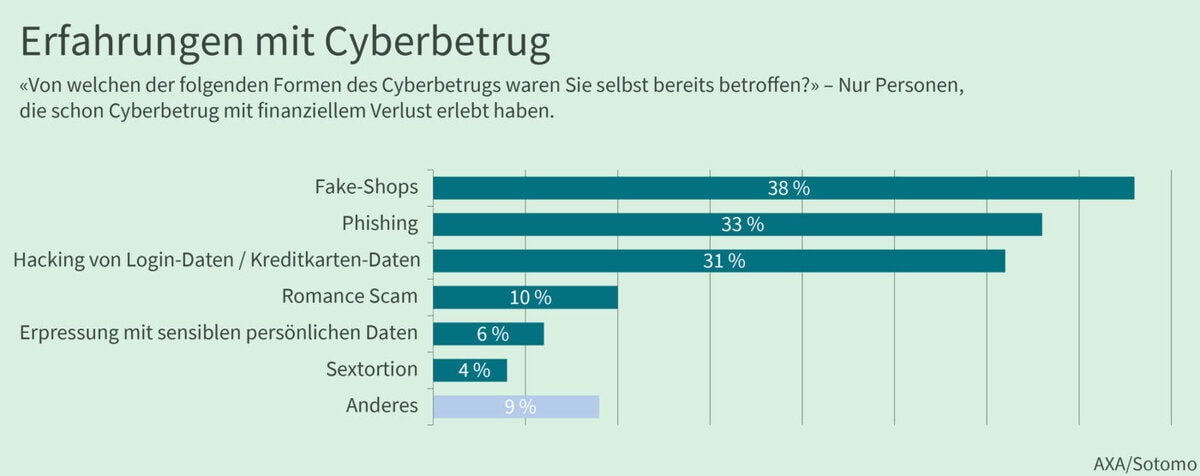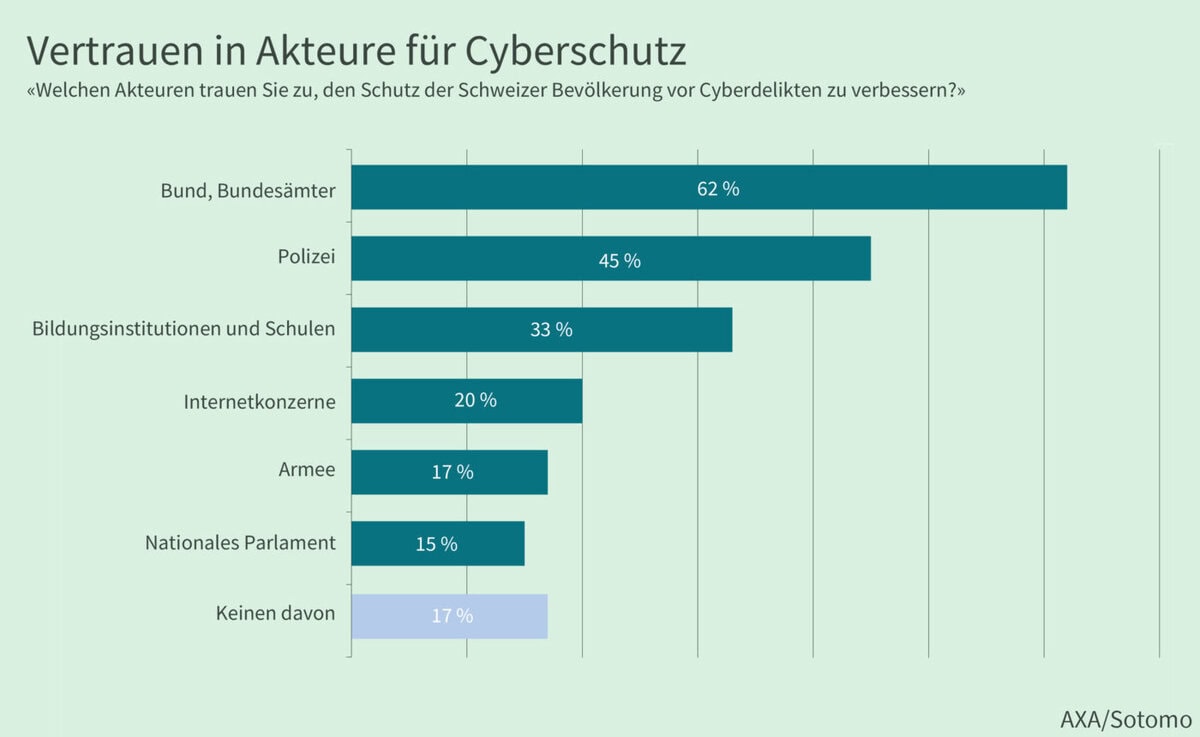AXA Cybersecurity Monitor: One in seven people have already lost money to cyber fraud
Of the people in Switzerland who have already experienced cyber fraud, only a third have reported the offense to the police, according to the first AXA Cyber Worry Monitor. One in seven adults has also been affected by cyber harassment - women and men alike. And more than half of them say that it is an emotional burden. In addition to cyber risks that directly affect individuals, Mr. and Mrs. Schweizer are also concerned about cyber attacks on critical infrastructure and the influencing of public opinion.

According to police crime statistics, cybercrime is on the rise. And they are causing concern among the Swiss population, as the AXA Cyber Worry Monitor shows. The study, conducted for the first time in collaboration with the Sotomo research institute, provides a comprehensive picture of what the population is concerned about when dealing with digital media. 78% of respondents believe that cybercrime poses significant challenges for our society. This means that cybercrime is seen as a challenge by just as many people as health insurance premiums or pension provision. "The special thing about this is that digital security is seen as a challenge across all party lines. Concern about cyber threats unites the political camps," says Michael Hermann, Head of Sotomo.

Concern for critical infrastructures
Cyberattacks on critical infrastructure (47 %), cyber fraud (44 %) and the influencing of public opinion through disinformation or fake profiles (44 %) are of particular concern to the population. By contrast, respondents are less concerned about technological dependence on foreign tech companies (17 %) or the negative impact of using digital devices on social life (18 %) and mental health (16 %). Women are slightly more concerned about cyber risks that directly affect individuals, i.e. cyber fraud and cyber harassment; men are slightly more concerned about cyber attacks on critical infrastructure. Overall, the challenges for companies and the state are considered to be particularly high. For private individuals, the issue is rated slightly less often as problematic. Nevertheless, a good half of respondents see cybercrime as a significant challenge for individuals.

Careless use of the internet
Online behavior influences the extent to which people are exposed to cyber risks - for example, measures such as complex passwords increase online security. "Significantly, the majority of respondents rate their own online behavior as appropriate, while conversely they attest that the rest of the population is careless," says Michael Hermann. More than two thirds rate the population's online behavior as too risky (71 %). In contrast, more than half consider their own behavior to be appropriate (55 %), if not (rather) too cautious (27 %). However, many feel as if the smartphone is gaining the upper hand over their own lives. Just under half of respondents (46 %) say they would like to spend less time on private digital devices. Many younger people (57 % of 18 to 29-year-olds) and women (52 %) in particular expressed this wish.

Cyber harassment equally prevalent among women and men
14 percent of the adult Swiss population state that they have experienced cyber harassment such as cyberbullying, hate speech or cyberstalking - 8 percent have experienced it in the last five years and 6 percent have experienced it longer ago. Men and women are equally affected. And what they have experienced burdens them: More than half (55 %) say the harassment had a strong or rather strong emotional impact on them. The emotional burden is particularly high among female victims. Two thirds of the women affected report a high or rather high level of stress. "So women are not more frequently affected by cyber harassment than men, but they are more frequently harassed in a way that puts them under emotional strain," says Katrin Sprenger, Head of AXA Cyber Prevention Services.
Only 23 percent of victims with high emotional distress reported the harassment to the police - almost as many did nothing (21 %). More often, the case was reported to the platform used (40 %) or attempts were made to confront the perpetrators themselves (26 %). The low number of reports to the police indicates that the actual number of cases of cyber harassment is far higher than the official crime figures. According to the survey, the most common form of cyber harassment experienced by the Swiss population is cyberbullying (39 %).

One in seven has lost money to cyber fraud
According to the results of the study, cyber fraud is also more widespread than official figures show: 15 percent of adults in Switzerland have already lost money through cyber fraud - almost 12 percent in the last five years and just under 4 percent before that. A third of them have suffered a loss of over 1,000 francs. The most common crimes were committed in fake stores (38 %) and the second most common were via phishing (33 %), i.e. fraudulent emails, text messages or phone calls that entice people to disclose sensitive information such as passwords or bank details on fake websites.
Only a third report cyber fraud to the police
According to police crime statistics, over 59,000 digital crimes were registered last year. However, the actual number is likely to be much higher. According to the AXA Cybersecurity Monitor, only 34% of people who have experienced cyber fraud resulting in financial loss reported the incident to the police. Even among those who have lost over a thousand francs, less than half (46 %) contacted the police. "The reasons for this reluctance probably include the low probability of suspects being identified and feelings of shame at having fallen for the scam," says Katrin Sprenger. However, the AXA Cybersecurity Monitor shows that anyone can be caught out and there is no clear type of victim. People of different ages and with different levels of education are equally affected.
Unclear how to react
In the case of both cyber fraud and cyber harassment, there is widespread uncertainty about how to react. Only just under a fifth feel sufficiently informed in this regard. Among those who have not yet experienced cyber fraud, 68% say they are sufficiently or fairly sufficiently informed. Among those who have already experienced cyber fraud with high financial losses, the figure is only 46%. "This is interesting, because the second group should actually be better informed, as they have already experienced it. This suggests that those affected only realize afterwards that they didn't know how to react in the event of a claim," says Katrin Sprenger.
Widespread trust in the federal government
In view of the major challenges and the complexity of the issue, the question arises as to who can improve the protection of the population against cybercrime. This reveals widespread trust in the federal government and the responsible federal offices such as the Federal Office for Cybersecurity. Two thirds trust the federal government to improve the protection of the population against cybercrime. In contrast, only 20% trust the internet companies to do this. "This is particularly interesting with regard to the ongoing debate on stricter regulation of platforms. The survey results indicate that voluntary self-regulation by the platforms is no longer sufficient for many citizens," says Michael Hermann.
About the study
The AXA Cybersecurity Monitor was created in collaboration with the Sotomo research institute. The representative survey with 1,706 participants was conducted between February 26 and March 10, 2025. The basic population of the survey is the language-integrated resident population from German-speaking and French-speaking Switzerland aged 18 and over.









